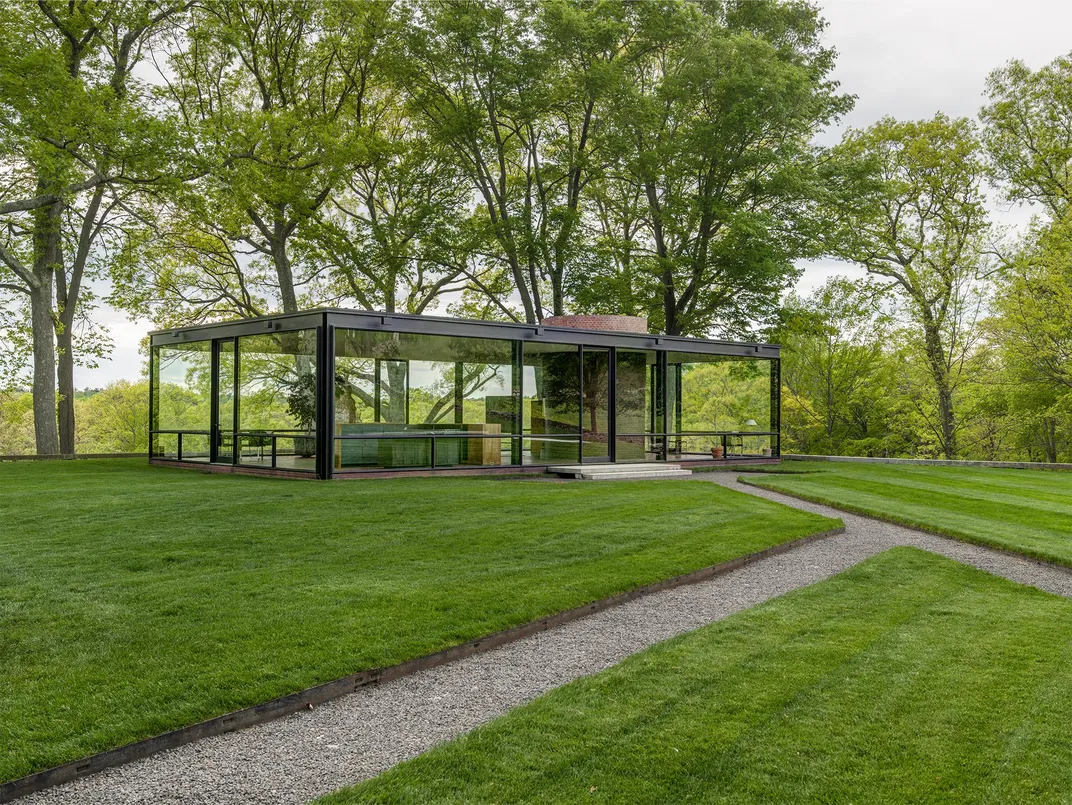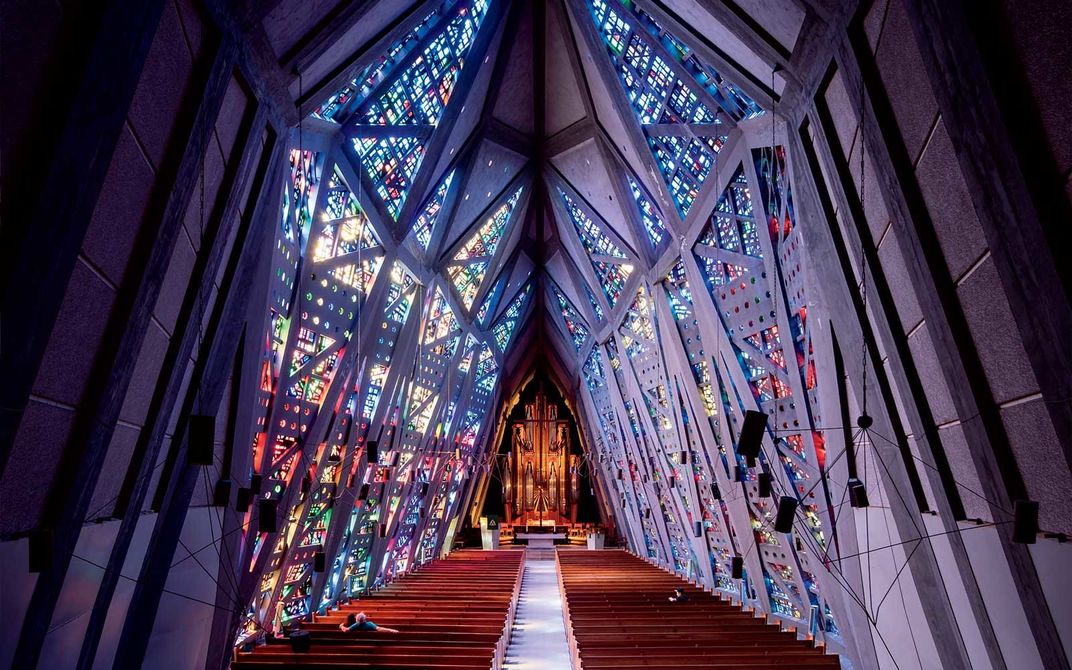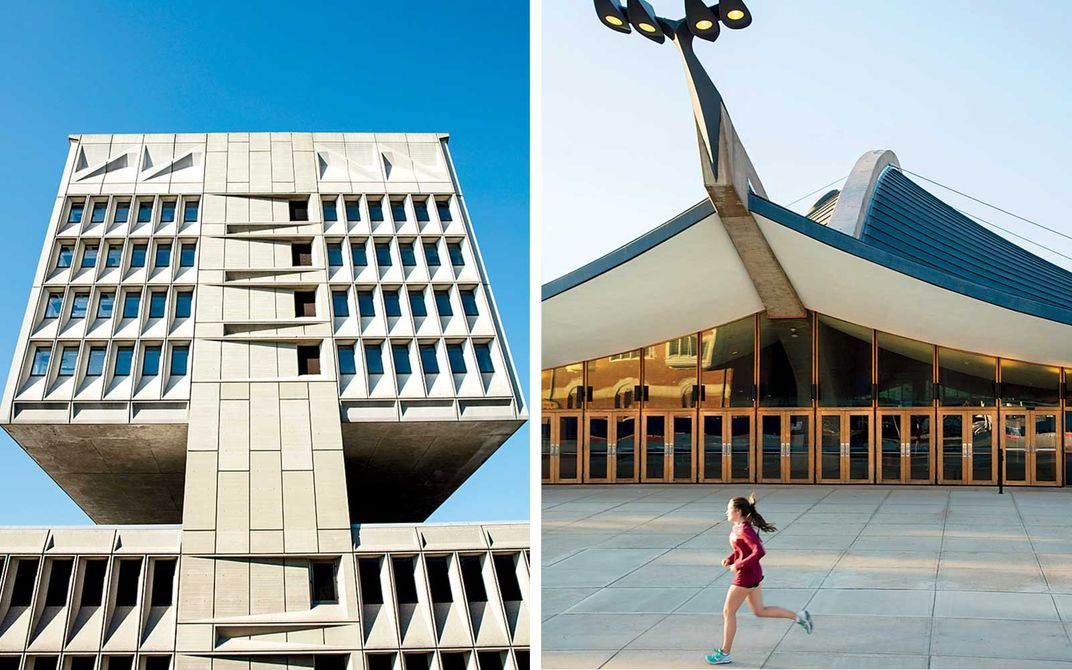Every Modern Architecture Lover Should Take This Three-Day Road Trip
In Connecticut, works by some of the most notable architects of the 20th century are hiding in plain sight. Take the wheel for this sightseeing tour
/https://tf-cmsv2-smithsonianmag-media.s3.amazonaws.com/filer/9e/b8/9eb8d332-47d4-4076-b690-f59d99652719/fish-church-glass-house-modernistct1017.jpg)
Think Connecticut, and the mind conjures up clapboard houses and picket fences. But architecture buffs know the state for glass walls, cement, and dark wood — the signature media of the Modernist architects who once made it their playground.
Connecticut Modernism began taking shape in the 1930s, when Walter Gropius, founder of the Bauhaus design school, fled Germany and took a position at Harvard's Graduate School of Design. His associate Marcel Breuer soon joined him, and together they mentored a generation of architects that included Modernist icons Landis Gores, John M. Johansen, Eliot Noyes, and Philip Johnson.
In the forties, as many of these pioneers began establishing Manhattan firms, they bought homes in Connecticut. Buoyed by the postwar boom, towns like New Canaan and Stamford became creative hot spots full of boldly designed residences, churches, and schools. In the sixties, as urban redevelopment swept the country, Modernist office buildings sprouted up. Today, several of the finest examples of this architectural era are concentrated between Stamford and Hartford — ideally situated for a three-day driving tour.
Day 1: Modern New Canaan
11 a.m.: Begin your journey in New Canaan, home of the so-called Harvard Five — Breuer, Gores, Johansen, Noyes, and Johnson. The town is most famous for Johnson's iconic Glass House (open May–November; tours from $25). The home is otherworldly: an 1,800-square-foot glass box in a vast meadow, it contains a few pieces of Mies van der Rohe Barcelona furniture and a central brick core holding the replace and bathroom. The grounds include other structures — a studio, a pavilion in a pond, a sculpture gallery — but from inside the house, all you can see is green.
2 p.m.: The centerpiece of nearby Irwin Park is the 1960 Gores Pavilion (open May–October), a onetime poolhouse with floor-to-ceiling windows, a cantilevered roof, and a bold Prairie fireplace — a nod to Frank Lloyd Wright. Preservationists saved the building from demolition in 2005, and it's now fully restored and outfitted with couches by another New Canaan resident: the Danish-American designer Jens Risom.
3 p.m.: Modernist it's not, but Grace Farms, a nonprofit community and spiritual center set on an 80-acre preserve, is an obligatory stop on the New Canaan architecture circuit. It's the site of River, a winding structure designed by Pritzker Prize–winning Japanese firm SANAA, with a sloped roof that connects a series of breezeways and interiors. Just a few minutes down the road is the privately owned Eliot Noyes House, where two glass wings flank a fern- and pine-filled courtyard. It's not usually open to the public, but if you're an architecture fan, it's worth timing your trip to catch one of the special tours offered by the Glass House or the local historical society.
6 p.m.: Finish your day in the bucolic Silvermine area of Norwalk at GrayBarns (doubles from $500). After a major overhaul, the 19th-century building was reopened this year as a boutique hotel and restaurant.

Day 2: Churches and Cityscapes
10 a.m.: Connecticut's mid-century architects dreamed up plenty of spectacular churches, but Stamford's First Presbyterian, created by Wallace Harrison, who later designed New York's Metropolitan Opera House, tops the list. Dubbed "the Fish Church" for its ichthyic shape, it has windows made of chunky, deeply saturated French dalle de verre stained glass, the first ever used in America. Lit by minimalist chandeliers, the glowing interior feels, as Harrison intended, like the center of a giant sapphire.

11:30 a.m.: On a hilltop in Westport, the Unitarian Church offers a woodsier experience. Designed by Victor Lundy in 1959, the building was inspired by a pair of hands at prayer, with a curved wooden roof bisected by a narrow skylight. Through the chapel's glass walls, churchgoers can look out onto a grove of elms and evergreens.
3 p.m.: On to Hartford, and some of America's first Bauhaus-inspired interiors at the Austin House, part of the vaunted Wadsworth Atheneum Museum of Art (tours three times a month, $25). Long before the Harvard Five made their mark, the city had A. Everett "Chick" Austin Jr., the museum's director, as its champion of Modernism. The first floor of his 1930 neo-Palladian mansion has Baroque-style décor befitting an 18th-century parlor. But upstairs it's like a different house. Mrs. Austin's dressing room, modeled after one Gropius had designed, feels particularly ahead of its time, with stainless steel, Breuer furniture, and black linoleum floors.
5 p.m.: Check in to the Goodwin (doubles from $249), a boutique hotel in an ornate 1881 building, which just reopened after a renovation. Then stroll a few blocks east to watch the sun set over the 1963 Phoenix Life Insurance Co. Building (1 American Row), the world's first office building with two faces, designed by Harrison's business partner Max Abramovitz. Its curved blue sides meet sharply at each end, which earned it the nickname "the Boat Building."

Day 3: New Haven, Beyond the Campus
11 a.m.: The grounds of Yale University are filled with Modernist buildings designed by former faculty members and students, like Eero Saarinen's Ingalls Rink (73 Sachem St.), whose sinusoidal roof earned it the nickname "the Whale," and Louis Kahn's Yale Art Gallery and Center for British Art. But the surrounding town should not be overlooked. Near the junction of I-91 and I-95 is a ghostly landmark: Breuer's 1968 Armstrong Rubber Co. Building. This classic example of his Brutalist work now stands partially demolished, but still handsome, in the parking lot of an IKEA. Recently, the first floor was opened for a site-specific art installation, Tom Burr/New Haven (by appointment only). When he was growing up nearby, Burr was always fascinated by the space. His conceptual piece — which mingles salvaged detritus from the building with nods to New Haven's history of political radicalism — offers a great chance to see its raw, rugged interiors.
12:30 p.m.: Before leaving town, stop to take in another Brutalist landmark, the Johansen-designed Dixwell Avenue Congregational United Church of Christ (217 Dixwell Ave.), just north of campus. Though the church was founded in 1820 by former slaves — and remains the oldest African American UCC church in the world — the current building dates from 1967. With vertical cut-stone slabs and a two-story central tower, the imposing structure is a great demonstration of how the streamlined style that arrived with refugees from Europe evolved into something bold, brash, and truly American.
- Why the Sky Turned Red in the United Kingdom
- This Week Could Be Your Last Chance Ever to Go All Out on Pumpkin Spice
- Airplanes Are About to Get Quieter — Here's Why That's a Good Thing
Planning Your Next Trip?
Explore great travel deals
Smithsonian magazine participates in affiliate link advertising programs. If you purchase an item through these links, we receive a commission.

